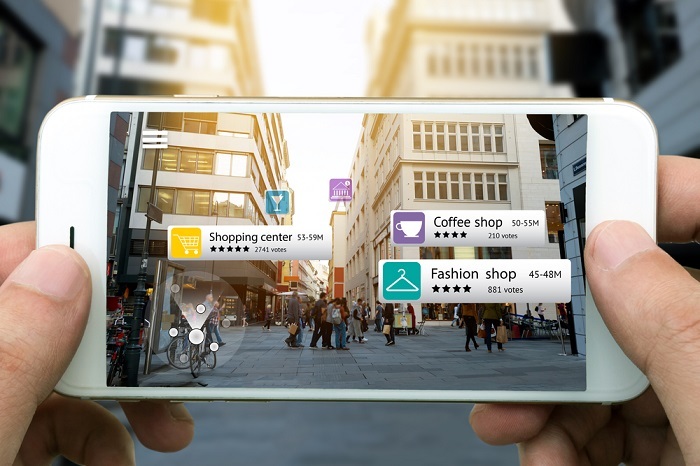
 Data Structure
Data Structure Networking
Networking RDBMS
RDBMS Operating System
Operating System Java
Java MS Excel
MS Excel iOS
iOS HTML
HTML CSS
CSS Android
Android Python
Python C Programming
C Programming C++
C++ C#
C# MongoDB
MongoDB MySQL
MySQL Javascript
Javascript PHP
PHP
- Selected Reading
- UPSC IAS Exams Notes
- Developer's Best Practices
- Questions and Answers
- Effective Resume Writing
- HR Interview Questions
- Computer Glossary
- Who is Who
How Augmented Reality is Changing the Shopping Experience
In recent years, technology has been transforming various aspects of our lives, and the shopping experience is no exception. Augmented reality (AR) has emerged as a game-changing technology that is revolutionizing the way we shop. By overlaying digital elements in the real world, AR enhances our perception and interaction with products, providing a more immersive and personalized shopping experience. In this article, we will explore the impact of augmented reality on the shopping experience, highlighting its benefits and providing examples of successful AR implementations.

Understanding Augmented Reality
Before diving into its impact, let's define augmented reality. Augmented reality is a technology that overlays digital information, such as virtual objects, text, or images, onto the real-world environment. It may be accessed by a variety of devices, including smartphones, tablets, smart glasses, and headsets. By blending the physical and digital worlds, AR enhances the real world with additional layers of information, creating a mixed-reality experience.
Transforming the In-Store Experience
Virtual Try-Ons ? One area where AR has made a significant impact is in the fashion and beauty industry. Virtual try-on applications allow shoppers to virtually try on clothes, accessories, and even makeup before making a purchase. Brands like Sephora and Warby Parker have implemented virtual try-on tools, enabling customers to see how products would look on them without physically trying them on. This technology enhances convenience and eliminates the need for time-consuming, traditional try-on sessions. According to a study conducted by the Virtual Reality Institute of Health and Exercise, virtual try-on experiences have been shown to increase customer engagement by 65%, leading to higher conversion rates.
Product Visualization ? Another way AR is changing the in-store experience is by providing interactive product visualizations. By utilizing AR, customers can view 3D models of products from various angles, explore different color options, and see how items would fit into their living spaces. For instance, furniture retailers like IKEA and Wayfair have integrated AR into their mobile apps, allowing customers to virtually place furniture in their homes to see how it fits and looks before making a purchase. This enables customers to make more informed decisions and reduces the likelihood of post-purchase regrets. According to a survey by Retail Perceptions, 61% of consumers prefer to shop at stores that offer augmented reality experiences, highlighting the growing demand for interactive product visualization.
Enhancing E-Commerce
Virtual Showrooms ? Augmented reality has also transformed the e-commerce landscape by introducing virtual showrooms. Brands can create virtual environments where customers can explore and interact with products in a more engaging and immersive manner. For example, automobile manufacturers like Audi and BMW have developed virtual showrooms that allow users to explore the interior and exterior of vehicles, customize features, and even take virtual test drives. This provides customers with a realistic experience that goes beyond traditional product images. According to a report by Goldman Sachs, virtual showrooms can reduce the need for physical showrooms by up to 50%, resulting in significant cost savings for businesses.
AR-based Product Information ? AR technology enables brands to provide customers with interactive product information. By scanning product packaging or labels with their smartphones, shoppers can access detailed specifications, and customer reviews, and even watch demonstration videos. This allows customers to make informed decisions and enhances their understanding of the product's features and benefits. Additionally, AR can provide real-time updates on product availability, promotions, and related items, further enhancing the customer's shopping experience. According to a survey conducted by Retail Dive, 61% of shoppers prefer to receive product information through augmented reality experiences, highlighting the effectiveness of this technology in delivering relevant and engaging content.
Bridging the Gap Between Online and Offline Shopping
One of the most significant impacts of augmented reality on the shopping experience is its ability to bridge the gap between online and offline retail. AR enables customers to bring the benefits of in-store shopping, such as trying on clothes or testing products, to the online environment. This enhances convenience, expands product offerings, and provides a more personalized and engaging experience for customers. By using AR, customers can virtually try on clothes or visualize products in their own space, making online shopping more interactive and realistic. According to a report by Gartner, by 2023, 100 million consumers will shop using augmented reality online and in-store, indicating the growing adoption and acceptance of AR as a shopping tool.
Success Stories
Nike ? The athletic apparel brand Nike implemented AR in its mobile app, allowing customers to virtually try on sneakers. By utilizing the app's camera, users can see how different shoe models would look on their feet. This AR feature has not only improved the shopping experience for customers but also resulted in increased customer engagement and higher conversion rates. According to Nike, customers who engage with the AR feature are 2.3 times more likely to make a purchase compared to those who do not use the feature.
L'Oréal ? L'Oréal, a global leader in cosmetics, launched the "Style My Hair" app, which utilizes AR to enable users to try different hairstyles and hair colors. This app allows customers to experiment with different looks before committing to a new hairstyle, enhancing their confidence in their purchase decisions. The AR-powered app has garnered positive feedback, leading to increased brand loyalty and sales. According to L'Oréal, the app has resulted in a 50% increase in sales conversion rates for hair color products.
Conclusion
Augmented reality is transforming the shopping experience by providing interactive and immersive interactions with products. From virtual try-ons to virtual showrooms, AR is revolutionizing the way we shop, both in physical stores and online. By enhancing convenience, expanding product offerings, and bridging the gap between online and offline retail, augmented reality is changing the way customers engage with brands and make purchasing decisions. As technology continues to advance, we can expect augmented reality to play an increasingly integral role in the future of shopping. Businesses that embrace AR stand to benefit from increased customer satisfaction, higher conversion rates, and a competitive edge in the evolving retail landscape. With the growing adoption of AR by both retailers and consumers, we can anticipate even more innovative and exciting applications of this technology in the years to come.

